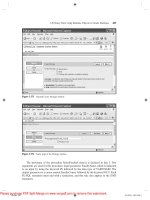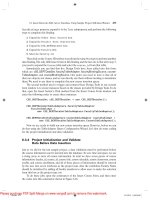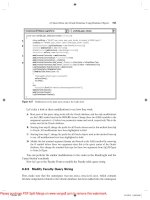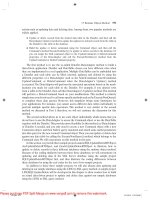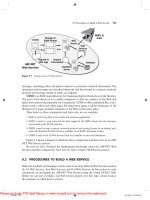Practical Computer Vision with SimpleCV pdf
Bạn đang xem bản rút gọn của tài liệu. Xem và tải ngay bản đầy đủ của tài liệu tại đây (37.96 MB, 177 trang )
www.it-ebooks.info
Practical Computer Vision with
SimpleCV
Nathan Oostendorp, Anthony Oliver, and Katherine Scott
Beijing
•
Cambridge
•
Farnham
•
Köln
•
Sebastopol
•
Tokyo
www.it-ebooks.info
Practical Computer Vision with SimpleCV
by Nathan Oostendorp, Anthony Oliver, and Katherine Scott
Revision History for the :
2012-05-01 Early release revision 1
See for release details.
ISBN: 978-1-449-32036-2
1335970018
www.it-ebooks.info
Table of Contents
Preface . . . . . . . . . . . . . . . . . . . . . . . . . . . . . . . . . . . . . . . . . . . . . . . . . . . . . . . . . . . . . . . . . . . . . vii
1. Introduction . . . . . . . . . . . . . . . . . . . . . . . . . . . . . . . . . . . . . . . . . . . . . . . . . . . . . . . . . . . 1
Why Learn Computer Vision 1
What is the SimpleCV framework? 2
What is Computer Vision? 2
Easy vs. Hard Problems 4
What is a Vision System? 5
Filtering Input 5
Extracting Features and Information 7
2. Getting to Know the SimpleCV framework . . . . . . . . . . . . . . . . . . . . . . . . . . . . . . . . . . 9
Installation 9
Windows 10
Mac 10
Linux 11
Installation from Source 12
Hello World 12
The SimpleCV Shell 14
Basics of the Shell 14
The Shell and the File System 18
Introduction to the Camera 19
A Live Camera Feed 23
The Display 24
Examples 27
Time-Lapse Photography 28
A Photo Booth Application 28
3. Image Sources . . . . . . . . . . . . . . . . . . . . . . . . . . . . . . . . . . . . . . . . . . . . . . . . . . . . . . . . . 31
Overview 31
Images, Image Sets & Video 32
iii
www.it-ebooks.info
Sets of Images 34
The Local Camera Revisited 35
The XBox Kinect 35
Installation 36
Using the Kinect 36
Kinect Examples 38
Networked Cameras 38
IP Camera Examples 40
Using Existing Images 41
Virtual Cameras 41
Examples 43
Converting Set of Images 44
Segmentation with the Kinect 44
Kinect for Measurement 46
Multiple IP Cameras 47
4.
Pixels and Images . . . . . . . . . . . . . . . . . . . . . . . . . . . . . . . . . . . . . . . . . . . . . . . . . . . . . . 51
Pixels 51
Images 53
Bitmaps and Pixels 53
Image Scaling 57
Image Cropping 61
Image Slicing 63
Transforming Perspectives: Rotate, Warp, and Shear 64
Spin, Spin, Spin Around 64
Flipping Images 67
Shears and Warps 68
Image Morphology 70
Binarization 71
Dilation and Erosion 73
Examples 76
The SpinCam 76
Warp and Measurement 77
5. The Impact of Light . . . . . . . . . . . . . . . . . . . . . . . . . . . . . . . . . . . . . . . . . . . . . . . . . . . . 81
Introduction 81
Light and the Environment 82
Light Sources 83
Light and Color 85
The Target Object 87
Lighting Techniques 90
Color 91
Color and Segmentation 94
iv | Table of Contents
www.it-ebooks.info
Example 96
6. Image Arithmetic . . . . . . . . . . . . . . . . . . . . . . . . . . . . . . . . . . . . . . . . . . . . . . . . . . . . . 103
Basic Arithmetic 103
Histograms 110
Using Hue Peaks 113
Binary Masking 115
Examples 116
Creating a Motion Blur Effect 116
Chroma Key (Green Screen) 118
7.
Drawing on Images . . . . . . . . . . . . . . . . . . . . . . . . . . . . . . . . . . . . . . . . . . . . . . . . . . . 121
The Display 122
Working with Layers 123
Drawing 128
Text and Fonts 135
Examples 138
Making a custom display object 139
Moving Target 142
Image Zoom 143
8. Basic Feature Detection . . . . . . . . . . . . . . . . . . . . . . . . . . . . . . . . . . . . . . . . . . . . . . . . 145
Blobs 146
Finding Blobs 147
Lines and Circles 153
Lines 153
Circles 158
Corners 162
Examples 164
Table of Contents | v
www.it-ebooks.info
www.it-ebooks.info
Preface
SimpleCV is a framework for use with Python. Python is a relatively easy language to
learn. For individuals who have no programming experience, Python is a popular lan-
guage for introductory computer and web programming classes. There are a wealth of
books on programming in Python and even more free resources available online. For
individuals with prior programming experience but with no background in Python, it
is an easy language to pick up.
As the name SimpleCV implies, the framework was designed to be simple. Nonetheless,
a few new vocabulary items come up frequently when designing vision systems using
SimpleCV. Some of the key background concepts are described below:
Computer Vision
The analyzing and processing of images. These concepts can be applied to a wide
array of applications, such as medical imaging, security, autonomous vehicles, etc.
It often tries to duplicate human vision by using computers and cameras.
Machine Vision
The application of computer vision concepts, typically in an industrial setting.
These applications are used for quality control, process control, or robotics. These
are also generally considered the “solved” problems. However, there is no simple
dividing line between machine vision and computer vision. For example, some
advanced machine vision applications, such as 3D scanning on a production line,
may still be referred to as computer vision.
Tuple
A list with a pair of numbers. In Python, it is written enclosed in parentheses. It is
often used when describing (x, y) coordinates, the width and height of an object,
or other cases where there is a logical pairing of numbers. It has a slightly more
technical definition in mathematics, but this definition covers its use in this book.
NumPy Array or Matrix
NumPy is a popular Python library used in many scientific computing applications,
known for its fast and efficient algorithms. Since an image can also be thought of
as an array of pixels, many bits of processing use NumPy’s array data type. When
an array has two or more dimensions, it is sometimes called a Matrix. Although
vii
www.it-ebooks.info
intimate knowledge of NumPy is not needed to understand this book, it is useful
from time to time.
Blob
Blobs are contiguous regions of similar pixels. For example, in a picture detecting
a black cat, the cat will be a blob of contiguous black pixels. They are so important
in computer vision that they warrant their own chapter. They also pop up from
time to time throughout the entire book. Although covered in detail later, it is good
to at least know the basic concept now.
JPEG, PNG, GIF or other image formats
Images are stored in different ways, and SimpleCV can work with most major image
formats. This book primarily uses PNG’s, which are technically similar to GIF’s.
Both formats use non-lossy compression, which essentially means the image qual-
ity is not changed in the process of compressing it. This creates a smaller image file
without reducing the quality of the image. Some examples also use JPEG’s. This
is a form of lossy compress, which results in even smaller files, but at the cost of
some loss of image quality.
PyGame
PyGame appears from time to time throughout the book. Like NumPy, PyGame
is a handy library for Python. It handles a lot of window and screen management
work. This will be covered in greater detail in the Drawing chapter. However, it
will also pop up throughout the book when discussing drawing on the screen.
Conventions Used in This Book
The following typographical conventions are used in this book:
Italic
Indicates new terms, URLs, email addresses, filenames, and file extensions.
Constant width
Used for program listings, as well as within paragraphs to refer to program elements
such as variable or function names, databases, data types, environment variables,
statements, and keywords.
Constant width bold
Shows commands or other text that should be typed literally by the user.
Constant width italic
Shows text that should be replaced with user-supplied values or by values deter-
mined by context.
This icon signifies a tip, suggestion, or general note.
viii | Preface
www.it-ebooks.info
This icon indicates a warning or caution.
Using Code Examples
This book is here to help you get your job done. In general, you may use the code in
this book in your programs and documentation. You do not need to contact us for
permission unless you’re reproducing a significant portion of the code. For example,
writing a program that uses several chunks of code from this book does not require
permission. Selling or distributing a CD-ROM of examples from O’Reilly books does
require permission. Answering a question by citing this book and quoting example
code does not require permission. Incorporating a significant amount of example code
from this book into your product’s documentation does require permission.
We appreciate, but do not require, attribution. An attribution usually includes the title,
author, publisher, and ISBN. For example: “Book Title by Some Author (O’Reilly).
Copyright 2011 Some Copyright Holder, 978-0-596-xxxx-x.”
If you feel your use of code examples falls outside fair use or the permission given above,
feel free to contact us at
Safari® Books Online
Safari Books Online is an on-demand digital library that lets you easily
search over 7,500 technology and creative reference books and videos to
find the answers you need quickly.
With a subscription, you can read any page and watch any video from our library online.
Read books on your cell phone and mobile devices. Access new titles before they are
available for print, and get exclusive access to manuscripts in development and post
feedback for the authors. Copy and paste code samples, organize your favorites, down-
load chapters, bookmark key sections, create notes, print out pages, and benefit from
tons of other time-saving features.
O’Reilly Media has uploaded this book to the Safari Books Online service. To have full
digital access to this book and others on similar topics from O’Reilly and other pub-
lishers, sign up for free at .
How to Contact Us
Please address comments and questions concerning this book to the publisher:
O’Reilly Media, Inc.
1005 Gravenstein Highway North
Preface | ix
www.it-ebooks.info
Sebastopol, CA 95472
800-998-9938 (in the United States or Canada)
707-829-0515 (international or local)
707-829-0104 (fax)
We have a web page for this book, where we list errata, examples, and any additional
information. You can access this page at:
page>
To comment or ask technical questions about this book, send email to:
For more information about our books, courses, conferences, and news, see our website
at .
Find us on Facebook: />Follow us on Twitter: />Watch us on YouTube: />x | Preface
www.it-ebooks.info
CHAPTER 1
Introduction
This chapter provides an introduction to computer vision in general and the SimpleCV
framework in particular. The primary goal is to understand the possibilities and con-
siderations to keep in mind when creating a vision system. In the process, this chapter
will cover:
• The importance of computer vision
• An introduction to the SimpleCV framework
• Hard problems for computer vision
• Problems that are relatively easy for computer vision
• An introduction to vision systems
• The typical components of a vision system
Why Learn Computer Vision
As cameras are becoming standard PC hardware and a required feature of mobile de-
vices, computer vision is moving from a niche tool to an increasingly common tool for
a diverse range of applications. Some of these applications probably spring readily to
mind, such as facial recognition programs or gaming interfaces like the Kinect. Com-
puter vision is also being used in things like automotive safety systems, where your car
detects when you start to drift from your lane, or when you’re getting drowsy. It is used
in point-and-shoot cameras to help detect faces or other central objects to focus on.
The tools are used for high tech special effects or basic effects, such as the virtual yellow
first-and-ten line in football games or motion blurs on a hockey puck. It has applications
in industrial automation, biometrics, medicine, and even planetary exploration. It’s
also used in some more surprising fields, such as with food and agriculture, where it is
used to inspect and grade fruits and vegetables. It’s a diverse field, with more and more
interesting applications popping up every day.
At its core, computer vision is built upon the fields of mathematics, physics, biology,
engineering, and of course, computer science. There are many fields related to com-
1
www.it-ebooks.info
puter vision, such as machine learning, signal processing, robotics, and artificial intel-
ligence. Yet even though it is a field built on advanced concepts, more and more tools
are making it accessible to everyone from hobbyists to vision engineers to academic
researchers.
It is an exciting time in this field, and there are an endless number of possibilities for
what you might be able to do with it. One of the things that makes it exciting is that
these days, the hardware requirements are inexpensive enough to allow more casual
developers entry into the field, opening the door to many new applications and inno-
vations.
What is the SimpleCV framework?
SimpleCV, which stands for Simple Computer Vision, is an easy-to-use Python frame-
work that bundles together open source computer vision libraries and algorithms for
solving problems. Its goal is to make it easier for programmers to develop computer
vision systems, streamlining and simplifying many of the most common tasks. You do
not have to have a background in computer vision to use the SimpleCV framework or
a computer science degree from a top-name engineering school. Even if you don’t know
Python, it is a pretty easy language to learn. Most of the code in this book will be
relatively easy to pick up, regardless of your programming background. What you do
need is an interest in computer vision or helping to make computers "see". In case you
don’t know much about computer vision, we’ll give you some background on the sub-
ject in this chapter. Then in the next chapter, we’ll jump into creating vision systems
with the SimpleCV framework.
What is Computer Vision?
Vision is a classic example of a problem that humans handle well, but with which
machines struggle. As you go through your day, you use your eyes to take in a huge
amount of visual information and your brain then processes it all without any conscious
thought. Computer vision is the science of creating a similar capability in computers
and, if possible, to improve upon it. The more technical definition, though, would be
that computer vision is the science of having computers acquire, process and analyze
digital images. You will also see the term machine vision used in conjunction with
computer vision. Machine vision is frequently defined as the application of computer
vision to industrial tasks.
One of the challenges for computers is that humans have a surprising amount of “hard-
ware” for collecting and deciphering visual data. You probably haven’t spent a lot of
time thinking about the challenges involved in processing what you see. For instance,
consider what is involved in reading this book. As you look at it, you first need to
understand what data represents the book and what is just background data that you
2 | Chapter 1: Introduction
www.it-ebooks.info
can ignore. One of the ways, you do this through depth perception, and your body has
several reinforcing systems to help with this:
• Eye muscles that can determine distance based on how much effort is exerted to
bend the eye’s lens.
• Stereo vision that detects slightly different pictures of the same scene, as seen by
each eye. Similar pictures mean the object is far away, while different pictures mean
the object is close.
• The slight motion of the body and head, which creates the parallax effect. This is
the effect where the position of an object appears to move when viewed from dif-
ferent positions. Since this difference is greater when the object is closer to you and
smaller when the object is further away, the parallax effect helps you judge the
distance to an object.
Once you have focused on the book, you then have to process the marks on the page
into something useful. Your brain’s advanced pattern recognition system has been
taught which of the black marks on this page represent letters, and how they group
together to form words. While certain elements of reading are the product of education
and training, such as learning the alphabet, you also manage to map words written in
several different fonts back to that original alphabet (Wingding fonts not withstand-
ing).
Take the above challenges of reading, and then multiply them with the constant stream
of information through time, with each moment possibly including various changes in
the data. Hold the book at a slightly different angle (or tip the e-reader a little bit). Hold
it closer to you or further away. Turn a page. Is it still the same book? These are all
challenges that are unconsciously solved by the brain. In fact, one of the first tests given
to babies is whether their eyes can track objects. A newborn baby already has a basic
ability to track but computers struggle with the same task.
That said, there are quite a few things that computers can do better than humans:
• Computers can look at the same thing for hours and hours. They don’t get tired
and they can’t get bored.
• Computers can quantify image data in a way that humans cannot. For example,
computers can measure dimensions of objects very precisely, and look for angles
and distances between features in an image.
• Computers can see places in a picture where the pixels next to each other have very
different colors. These places are called "edges", and computers can tell you exactly
where edges are, and quantitatively measure how strong they are.
• Computers can see places where adjacent pixels share a similar color, and give you
measurements on shapes and sizes. These are often called "connected compo-
nents", or more colloquially, "blobs".
What is Computer Vision? | 3
www.it-ebooks.info
• Computers can compare two images and see very precisely the difference between
those two images. Even if something is moving imperceptibly over hours—a com-
puter can use image differences to measure how much it changes.
Part of the practice of computer vision is finding places where the computer’s eye can
be used in a way that would be difficult or impractical for humans. One of the goals of
this book is show how computers can be used to see in these cases.
Easy vs. Hard Problems
Computer vision problems, in many ways, mirror the challenges of using computers in
general: computers are good at computation, but weak at reasoning. Computer vision
will be effective with tasks such as measuring objects, identifying differences between
objects, finding high contrast regions, etc. These tasks all work best under conditions
of stable lighting. Computers struggle when working with irregular objects, classifying
and reasoning about an object, tracking objects in motion, etc. All of these problems
are compounded by poor lighting conditions or moving elements.
For example, consider the image shown in Figure 1-1. What is it a picture of? A human
can easily identify it as a bolt. For a computer to make that determination, it will require
a large database with pictures of bolts, pictures of objects that are not bolts, and com-
putation time to train the algorithm. Even with that information, the computer may
regularly fail, especially when dealing with similar objects, such as distinguishing be-
tween bolts and screws.
However, a computer does very well at tasks such as counting the number of threads
per inch. Humans can count the threads as well, of course, but it will be a slow and
error prone, not to mention headache inducing, process. In contrast, it is relatively easy
to write an algorithm that detects each thread. Then it is a simple matter of computing
the number of those threads in an inch. This is an excellent example of a problem prone
to error when performed by a human, but easily handled by a computer.
Some other classic examples of easy vs. hard problems include:
Figure 1-1. Hard: What is this? Easy: How many threads per inch?
4 | Chapter 1: Introduction
www.it-ebooks.info
Table 1-1. Easy and hard problems for computer vision
Easy Hard
How wide is this plate? Is it dirty? Look at a picture of a random kitchen and find all the
dirty plates.
Did something change between these two images? Track an object or person moving through a crowded
room of other people
Measure the diameter of a wheel. Check if it is bent. Identify arbitrary parts on pictures of bicycles.
What color is this leaf? What kind of leaf is this?
Furthermore, all of the challenges of computer vision are amplified in certain environ-
ments. One of the largest challenges is the lighting. Low light often results in a lot of
noise in the image, requiring various tricks to try to clean up the image. In addition,
some types of objects are difficult to analyze, such as shiny objects that may be reflecting
other objects in their surroundings.
Note that hard problems do not mean impossible problems. The later chapters of this
book look at some of the more advanced features of computer vision systems. These
chapters will discuss techniques such as finding, identifying, and tracking objects.
What is a Vision System?
A vision system is something that evaluates data from an image source (typically a
camera), extracts data about those images, and does something with the results. For
example, consider a parking space monitor. This system watches a parking space, and
detects parking violations in which unauthorized cars attempt to park in the spot. If
the owner’s car is in the space or if the space is empty, then there is no violation. If
someone else is parked in the space, then there is a problem. Figure 1-2 outlines the
overall logic flow for such a system.
Although conceptually simple, the problem presents many complexities. Lighting con-
ditions affect color detection and the ability to distinguish the car from the background.
The car may be parked in a slightly different place each time, hindering the detection
of the car versus an empty spot. The car might be dirty, making it hard to distinguish
the owner’s car versus a violator’s. The parking spot could be covered in snow, making
it difficult to tell whether the parking spot is empty.
To help address the above complexities, a typical vision system has two general steps.
The first step is to filter the input to narrow the range of information to be processed.
The second step is to extract and process the key features of the image(s).
Filtering Input
The first step in the machine vision system is to filter the information available. In the
parking space example, the camera’s viewing area most likely overlaps with other
What is a Vision System? | 5
www.it-ebooks.info
parking spaces. A car in an adjacent parking space or a car in a space across the street
is fine. Yet if they appear in the image, the car detection algorithm could inadvertently
pick up these cars, creating a false positive. The obvious approach would be to crop
the image to cover only the relevant parking space, though this book will also cover
other approaches to filtering.
In addition to the challenge of having too much information, images must also be
filtered because they have too little information. Humans work with a rich set of in-
formation, potentially detecting a car using multiple sensors of input to collect data
and compare it against some sort of pre-defined car pattern. Machine vision systems
have limited input, typically from a 2D camera, and therefore must use inexact and
potentially error-prone proxies. This amplifies the potential for error. To minimize
errors, only the necessary information should be used. For example, A brown spot in
Figure 1-2. Diagram of parking spot vision system
6 | Chapter 1: Introduction
www.it-ebooks.info
the parking space could represent a car, but it could also represent a paper bag blowing
through the parking lot. Filtering out small objects could resolve this, improving the
performance of the system.
Filtering plays another important role. As camera quality improves and image sizes
grow, machine vision systems become more computationally taxing. If a system needs
to operate in real time or near real time, the computing requirements of examining a
large image may require unacceptable processing time. However, filtering the infor-
mation controls the amount of data and decreases how much processing that must be
done.
Extracting Features and Information
Once the image is filtered by removing some of the noise and narrowing the field to
just the region of interest, the next step is to extract the relevant features. It is up to the
programmer to translate those features into more applicable information. In the car
example, it is not possible to tell the system to look for a car. Instead, the algorithm
looks for car-like features, such as a rectangular license plate, or rough parameters on
size, shape, color, etc. Then the program assumes that something matching those fea-
tures must be a car.
Some commonly used features covered in this book include:
• Color information: looking for changes in color to detect objects.
• Blob extraction: detecting adjacent, similarly colored pixels.
• Edges and corners: examining changes in brightness to identify the borders of ob-
jects.
• Pattern recognition and template matching: adding basic intelligence by matching
features with the features of known objects.
In certain domains, a vision system can go a step further. For example, if it is known
that the image contains a barcode or text, such as a license plate, the image could be
passed to the appropriate barcode reader or Optical Character Recognition (OCR)
algorithm. A robust solution might be to read the car’s license plate number, and then
that number could be compared against a database of authorized cars.
What is a Vision System? | 7
www.it-ebooks.info
www.it-ebooks.info
CHAPTER 2
Getting to Know the SimpleCV
framework
The goal of the SimpleCV framework is to make common computer vision tasks easy.
This chapter introduces some of the basics, including how to access a variety of different
camera devices, how to use those cameras to capture and perform basic image tasks,
and how to display the resulting images on the screen. Other major topics include:
• Installing the SimpleCV framework
• Working with the shell
• Accessing standard webcams
• Controlling the display window
• Creating basic applications
Installation
The SimpleCV framework has compiled installers for Windows, Mac, and Ubuntu
Linux, but it can also be used on any system that Python and OpenCV can be built on.
The installation procedure varies for each operating system. Since SimpleCV is an open
source framework, it can also be installed from source. For the most up to date details
on installation, go to This section pro-
vides a brief overview of each installation method.
Regardless of the target operating system, the starting point for all installations is http:
//www.simplecv.org. The home page includes links for downloading the installation
files for all major platforms. The installation links are displayed as icons for the Win-
dows, Mac, and Ubuntu systems.
9
www.it-ebooks.info
Clicking the download button on , goes to a
page that automatically downloads the installer for your current oper-
ating system. To download the installer for a different operating system,
go to and select the down-
load for the desired operating system. The Windows filename extension
is .exe, and the Mac’s is .pkg. With Ubuntu Linux, the extension is .deb.
Windows
By far the easiest way to install the SimpleCV framework on Windows is by using the
Windows Superpack. Clicking the download link from will
download the Superpack from . Simply download the Superpack
and follow the instructions. In addition to the basic installation, it will also check for
and download any missing dependencies. The following are the required dependencies:
• Python 2.7
• Python Setup Tools
• NumPy
• SciPy
• Easy_install
• OpenCV
Once the installation is complete, it will create a SimpleCV program group under the
Start menu. This includes a link to start the SimpleCV interactive Python shell and a
link to access the program documentation. The majority of the examples in this book
can be run using the SimpleCV Shell. More details regarding the shell are covered in
the SimpleCV Shell section of this chapter.
Mac
There have been substantial changes made to the available software and
development tools between different versions of Mac OS X. As a result,
the installation instructions for Macs are likely to change in response to
the ever evolving underlying configuration of the operating system.
Please see for the latest installation instruc-
tions.
Before beginning a Mac install, it is strongly recommended that XCode
be installed from Apple. On some versions of Mac OS X, this will resolve
dependency and installation errors. To download, see https://developer
.apple.com/xcode. You will also need to install the Command Line Tools
from within Xcode (Xcode→Preferences→Downloads→Components).
10 | Chapter 2: Getting to Know the SimpleCV framework
www.it-ebooks.info
The Mac installation follows a template similar to the Windows approach. From the
SimpleCV home page, click the download button. It will go to SourceForge.net and
begin downloading the installation Superpack. This package will handle the installation
of the SimpleCV framework and its major dependencies. The list of dependencies is
the same as it is for Windows:
• Python 2.7
• Python Setup Tools
• NumPy
• SciPy
• Easy_install
• OpenCV
Because the SimpleCV framework integrates with Python, the Superpack installs files
in places other than the Applications directory. It will also install binary dependencies
in /usr/local, and Python libraries in /Library/Python2.7. If you already have a Mac-
Linux system in place, such as Homebrew, Ports, or Fink, you may want to follow the
instructions to install from source.
The easiest way to work with the examples below is from the Python shell. Once the
SimpleCV framework is installed, you can either click on the SimpleCV.command icon in
the Applications folder, or start iPython from a terminal window. To start a terminal
window, go to the Applications folder, find the Utilities folder, and then click on Ter-
minal to launch it. This will bring up a command prompt. At the command prompt,
type python -m SimpleCV.__init__ to bring up the SimpleCV interactive Python shell.
Most of the examples in this book can be run from the SimpleCV Shell.
Linux
While the following instructions are for Ubuntu Linux, they should also work for other
Debian-based Linux distributions. Installing SimpleCV for Ubuntu is done through
a .deb package. From the SimpleCV home page, click the download button, which is
the rightmost of the three logos. This will download the package and handle the in-
stallation of all the required dependencies.
Note, however, that even recent distributions of Ubuntu may have an out of date ver-
sion of OpenCV, one of the major dependencies for SimpleCV. If the installation throws
errors with OpenCV, in a Terminal window enter:
$ sudo add-apt-repository ppa:gijzelaar/opencv2.3
$ sudo apt-get update
Once SimpleCV is installed, start the SimpleCV interactive Python shell by opening a
command prompt and entering python -m SimpleCV.__init__. A majority of the ex-
amples in this book can be completed from the SimpleCV Shell.
Installation | 11
www.it-ebooks.info
Installation from Source
Some users may want to have the bleeding edge version of SimpleCV installed. Sim-
pleCV is an open source framework, so the latest versions of the source code are freely
available. The source code for SimpleCV is available on GitHub. The repository can be
cloned from :ingenuitas/SimpleCV.git.
A full description of using GitHub is beyond the scope of this book. For more infor-
mation, see .
Once the source code is installed, go to the directory where it was downloaded. Then
run the following command at the command prompt:
$ python setup.py install
Installation from source does not automatically install the required de-
pendencies. As a shortcut for installing dependencies, it may be easiest
to first install SimpleCV using the appropriate package described above.
This doesn’t guarantee that the newest dependencies will be resolved,
but it will streamline the process.
Hello World
As is mandated by the muses of technical writing, the first example is a basic Hello
World app. This application assumes that the computer has a built-in webcam, a cam-
era attached via USB, or a similar video device attached to it. It will then use that camera
to take a picture and display it on the screen.
The SimpleCV framework uses Python. For those who want a little more
background on Python, check out Learning Python by Mark Lutz for a
good introduction to the language.
from SimpleCV import Camera, Display, Image
# Initialize the camera
cam = Camera()
# Initialize the display
display = Display()
# Snap a picture using the camera
img = cam.getImage()
# Show the picture on the screen
img.save(display)
12 | Chapter 2: Getting to Know the SimpleCV framework
www.it-ebooks.info
Either copy the code above into the SimpleCV Shell or save the above code as hello
World.py using a plain text editor and run the program. For those who have not worked
with Python before, these are the basic steps:
• Open a terminal window or the command prompt
• Go to the directory where helloWorld.py is saved
• Type python helloWorld.py and press the Enter key.
Once the program has started, look at the webcam, smile, wave, and say, "Hello
World." The program will take a picture and display it on the screen.
This example program uses three of the most common libraries provided by the Sim-
pleCV framework: Camera, Display, and Image. These will be covered in greater detail
later in this book; however, a brief introduction to the program follows:
The first line of code imports the libraries used in this program. Technically, Image
does not need to be specifically listed since Python already knows that Camera will
return Image objects. It is simply included here for clarity.
The next two lines are constructors. The first line initializes a Camera object to be
able to capture the images, and the second line creates a Display object for displaying
a window on the screen.
This line uses the getImage() function from the Camera class, which snaps a picture
using the camera
The final line then “saves” the image to the display, which makes the image appear
on the screen.
Hello World purists may object that this program does not actually display the text,
“Hello World.” Instead, the example relies on the user to say the words while the picture
is taken. This situation is easily resolved. Image objects have a drawText() function that
can be used to display text on the image. The following example demonstrates how to
create a more traditional Hello World program.
from SimpleCV import Camera, Display, Image
import time
# Initialize the camera
cam = Camera()
# Initialize the display
display = Display()
# Snap a picture using the camera
img = cam.getImage()
# Show some text
img.drawText("Hello World!")
# Show the picture on the screen
img.save(display)
# Wait five seconds so the window doesn't close right away
time.sleep(5)
Hello World | 13
www.it-ebooks.info
The program will appear almost identical to the original Hello World example, except
it now draws the text “Hello World” in the middle of the screen. You might also notice
that there are a few new lines: import time at the top of the program, and
time.sleep(5) at the bottom. The import time line imports the time module from
Python’s standard library. The sleep() function from the time module is then used at
the end of the program to delay closing the window for 5 seconds.
At this point, you have created a very simple computer vision program, using the Cam-
era, Display, and Image classes. Of course, this is only the tip of the iceberg.
The SimpleCV Shell
Before going into more depth regarding the features of the SimpleCV framework, this
is a good point to pause and discuss one of the best tools to use when working with
this book. Most of this book is based on using small snippets of code to do cool things.
Yet the traditional way to code is to create a new file, enter the new code, save the file,
and then run the file to see if there are errors. If there are errors (and there are always
errors), you have to open the file, fix the errors, re-save the file, and re-run the file—
and keep doing this loop until all of the errors are fixed. This is an extremely cumber-
some process when working with little code snippets. A much faster way to work
through the examples is with the SimpleCV Shell, or simply “the Shell” as it is called
in this book. The Shell is built using IPython, an interactive shell for Python develop-
ment. This section introduces the basics of working with the shell. Additional tutorials
and more advanced tricks are available on IPython’s web site, .
Most of the example code in this book is written so it could be executed as a stand
alone script. However, this code can be still be run in the SimpleCV Shell. There are a
few examples that should only be run from the shell, because they won’t run properly
as a standard script. These examples are mainly to illustrate how the shell works. In
these cases, the example code will include the characters >>> at the beginning of each
line to indicate that it is expected to be run in the shell. When you type this example
code into the shell, you don’t want to include this initial >>> characters. For instance,
in the shell, you can access an interactive tutorial, launching it with the tutorial com-
mand demonstrated below:
>>> tutorial
When you actually type this into the shell, only want to enter the word ‘tutorial’ and
hit the enter key. Do not type the >>> string. The >>> merely indicates that it is a com-
mand to be entered in the shell.
Basics of the Shell
Some readers may have had prior experience working with a shell on a Linux system,
MS-DOS or software like Matlab, SPSS, R, or Quake 3 Arena. Conceptually, the Sim-
pleCV Shell has many similarities. Whereas the operating system shells take text-based
14 | Chapter 2: Getting to Know the SimpleCV framework
www.it-ebooks.info



